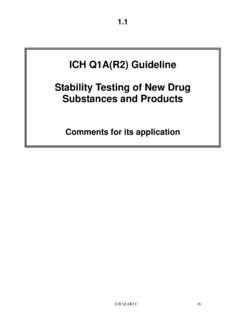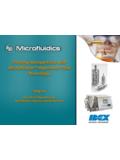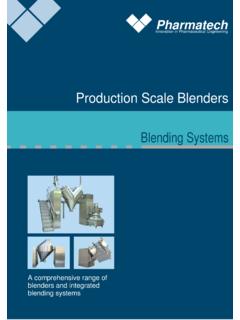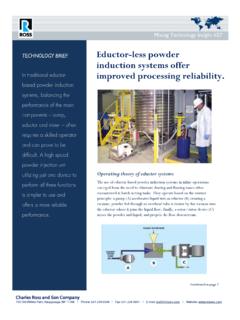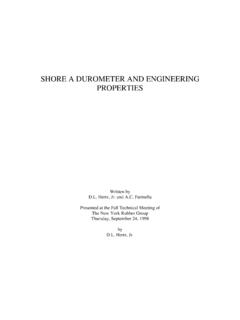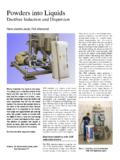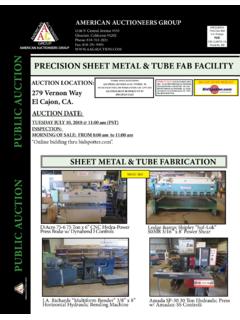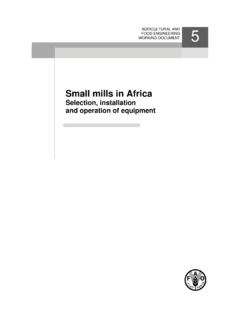Transcription of Solid Oral Dosage Forms Powder Blending - IKEV
1 Scott Bozzone, OperationsCork, IrelandSolid oral Dosage FormsPowder Blending KEV Meeting May 31, 2001 Mechanisms of Powder Blending Diffusion- redistribution of particles by random motion Vertical or axial motion Seen in rotational blenders Convection- transfer from one location to another Motion imparted by impeller as in Ribbon Blender Shear-formation of slip planes Motion imparted by high intensity mixersClassification of Mixing EquipmentMechanismEquipmentDiffusionV-Bl ender (Twin Shell)(Tumble)Double Cone BlenderBin BlenderHorizontal/Vertical DrumConvectionRibbon(Paddle or Plow)PlanetaryHorizontal High IntensityVertical High IntensityDiffusion (with I-Bar)PneumaticFluid Bed(Expansion with Gas)ReimeltReference: FDA Draft Guidance- SUPAC IR/MR-Scale-Up Post Approval Changes - Immediate and Modified Release - Equipment Addendum, April 1998; Selection vs.
2 Material Type Non-cohesive blend(flows & mixes easily) Bin Blender Twin Shell Other precision, rotational blender Cohesive blend(lumpy, not free-flowing) High Shear ( Twin Shell w/ I-Bar, Colette, Lodige) Ordered Mix(drug << excipient) Tumbling mixers, cone mixer, high energy many types are allowable. Drug is glued to larger excipient particles Drug may coat larger excipient particlesExcipientDrugRotating Shell BlendersV-shaped BlenderDirectionofRotationAxis of RotationShaft DriveDouble-cone BlenderShaft DriveAxis of RotationDirectionofRotationKeep shell tip speed constant at approximately 100 m/min (300 ft/min)
3 Rotating Shell BlendersBarrel BlenderDirection of RotationAxis of Rotation++Bin BlenderShaft DriveDirection of RotationAxis of RotationPhysical Properties of Blend ComponentsMaterials Active Ingredients Excipients Dried Milled Granulations Final BlendsTests Particle size Distribution (coarse, medium, fine) Density (loose or bulk, tapped) If possible, match particle size/densities, especially for dry blends. For example, Break-up lumpy excipients with delumping agents ( SiO2) Screen/ delump actives with excipients Coarse particle sizes could create content uniformity in Blending Blender Volume Usually 60% ( 10%) of total air volume is working volume (40% air to mix and flow).
4 Example: total air volume: 3000L, working vol: 2000 L (66%); Density - g/mL; Batch size is 1,000 Kg. Sliding (cascading) fall vs drop. Blend times for pharmaceuticals: typically 10-20 minutes. Obtain accurate Powder density from trials Constant batch size Visual and calculated observations (before/ after Blending ) Nature of material Raw Material physical properties are in controlNeed for PreblendingDirectBlendingPreblending(Non geometric)Preblending(Geometric)Solvent Addition>5-10% Active 1-5% Active< 1%< activeStraightmixingUse (drug fraction)1/2{ ( )1/2 = 20%.}
5 4 Kg drug + 16 KgExcipient}- Preblend1:1 (Drug:Exc),1:1 (Mix: Exc),1:1 (Mix: Exc),and so in liquidand spray/coat/granulateAdequateGood methodCumbersome For low doseproducts ( )Scale-Up of BlendingWorking Capacity(L)Typical RPMT ypical Amount(Kg)20-5025 308-3025022 2880-15050012 18200-30020008 12800-1200 Rotational velocity is key Blending parameterRotational Tip speed (100 m/min) and momentum (mass xvelocity) stay same during scale-up; as mass increasesblender RPM of Blending Pilot Plant development Evaluate and determine Blending times Start at 10 min, sample every minute thereafter Select three times and bracket with acceptable results Sampling methods, sizes, and locations are developed Determine if Blending is critical ( sensitive, problematic) Qualify Production Blender Verify Blending time and rotational speed Production Blending instructions Specific, precise Blending speed and Blending time.
6 Ranges are not usually in batch directions No variation from batch to batchSegregation (Demixing of components) Occurs during Blending , transport, storage or discharge. Seen mostly during transport and discharge. Greater with free-flowing powders since they can separate easily (based on size, shape, and density) Overcome by Minimizing physical differences Increasing cohesiveness of formulation Optimizing Blending conditionsTypes of Segregation Sifting - smaller particles slipping between larger ones. Particle size differences > 3:1 Mean Particle size > 300 m Free flowing pile formed through funnel Major component is > 3 times minor - Granules on top of Powder bed in tablet press hopper or coarse particles at the end of a container.
7 Related to Vibration effectsthat may accelerate the sifting : Narrower particle size distribution More cohesiveness Reduce material handling (discharge, scooping, transport) Change equipment design (angles, vents, cone-in-bin) Use equal portions if possible (50/50 mix)Types of Segregation, Aeration (percolation) or Fluidization causes fines to travel to the top with air. Particle size differences Excessive high shear mixing (air introduced during Blending ) Settling effects Dusting or particles in the air - fines accumulating at side or perimeter of drum/bin. Arching or rat holing - different angle of repose and cohesiveness of mix components leads to differences in sliding, mixing, and discharge pattern of mix components.
8 Segregation by FluidizationReference: Pharm Tech, June configuration-too much air during fillingRevised Configuration-less air effect as it enters tangentiallyPlan ViewElevation+Layer of linesLined to provide mass flow+Measuring Angle of Repose 2RH Fixed-Funnel 2 RHFixed-Bed Cone Tilting BoxRevolving CylinderAngle of Repose for Different Sieve Cuts of MgO304050600100 200 300 400 500 600 700 800 Repose Angle (degrees)Diameter ( m)Smaller particles have a higher angle or pileSide-by-side Loading:Diffusion Paces BlendV-type Blenders: Effect of loadingLayer-by-layer Loading:Convection Paces Blend V-type Mixer = 70 -80 Funnel Flow and Mass Flow Patterns40 30 20 10 0 0 10 20 30 40 50 Wall Friction Angle ( )Hopper Angle from Vertical ( c)Mass FlowFunnel FlowUncertainHigher wall friction requires steeper hopper angle (smaller c) to maintain mass Flow Angle Design for HopperReference: J.
9 Prescott, Pharm Tech Europe, Jan HopperBottomMovingFunnel flow(Segregation is worst)Mass flow cRapid drop of Powder into a Y-branch above tablet press leads to air entrainmentReference: Pharm Tech, June Configuration-airstream carried finesTableting Machine35 7 -0 Revised Configuration;Vent allows air to bypassTableting MachineButterfly valveRefs: 1) Chang, R-K. Drug Dev. Ind. Pharm., 22 (9),1031-1035 (1996).2) Garcia, Pharm Dev. Tech.,3 (1), 7-12 (1998).Sampling Methods Static Bed - sample thieves Globe (side sampling) - most common End Streamline End Core sampling device Flow stream (during dynamic discharge) Best to sample entire stream for very short Quantity and Frequency In Development phase, pull 1-3x Unit Dose or larger samples.
10 If 1-3x is problem, test larger samples to assess bias. Justify deviation from 1-3x dose size. [Below has been problematic, is optimal.] During Validation, Use recommended sample size from Development. Minimum ten locations, three per location (total of 30 samples per batch). Must include worst-case locations. Test 10 samples per batch. Test other 20 samples per USP <905> protocol, if needed If drug content is > 50% (or 50 mg) in Dosage form , blend uniformity is not needed. (Dickinson s FDA Review, Nov. 1998)Sampling Locations in V- Blender1st Sample SetA= Left-Left-Top (left arm)2nd Sample SetB=Left arm-Left-MiddleC= Left arm-Left-BottomD= Discharge Port3rd Sample SetE= Left arm-Center-MiddleF= Center-Center-Center G= Right-Right-Bottom4th Sample SetH= Right-Right-TopI= Right-Right-Middle5th Sample SetJ= Right-Right-Top (right arm)Diagram Shows Approximate Two-Dimensional Sample Locations for a Twin Shell Blender++ABDECFHIJG1st Sample SetA= Left-Top (left arm)
